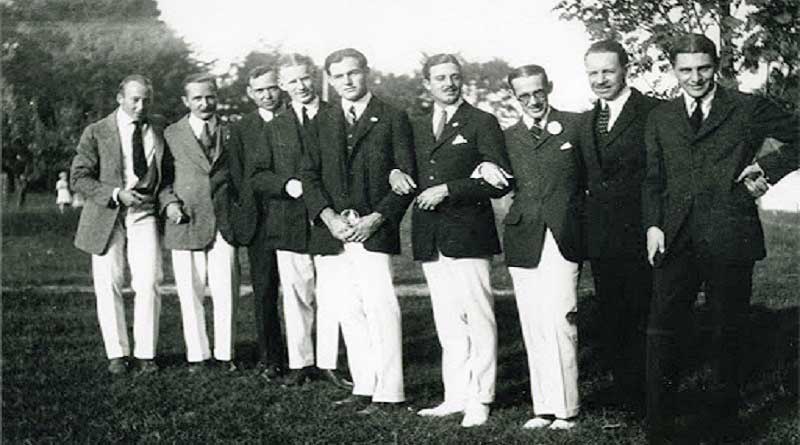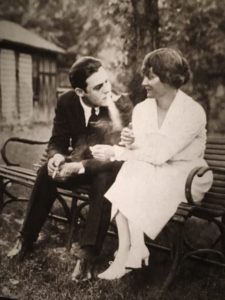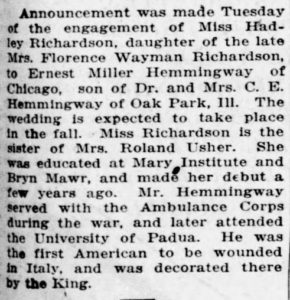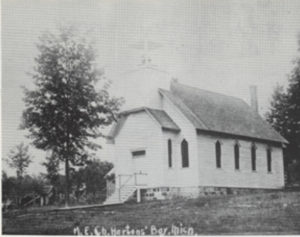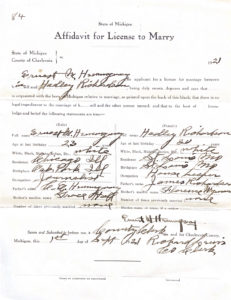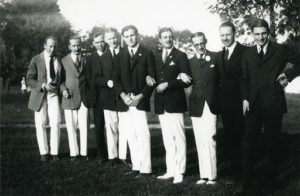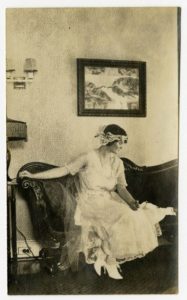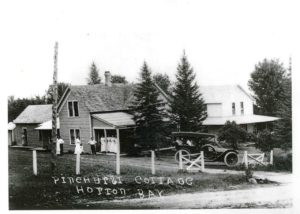FAREWELL TO BACHELORHOOD: Ernest Hemingway’s Wedding in Northern Michigan
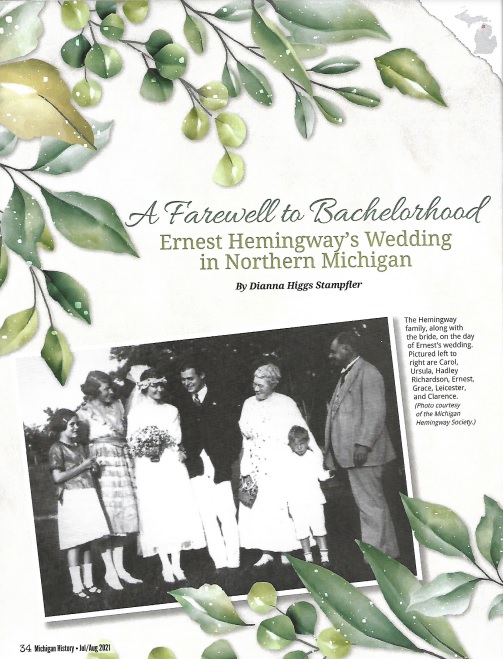
By Dianna Stampfler
It should come as no surprise that Ernest Hemingway chose northern Michigan as the setting for his first wedding. This rural countryside was his first real love, so it was fitting that he and his muse would begin their marriage alongside the towering trees and flowing rivers which shaped his life.
Ernest Miller Hemingway was born on July 21, 1899 in Oak Park, IL to Dr. Clarence and Grace (Hall) Hemingway, the second of eventually six children. His first visit to northern Michigan was in September of that year, when he was a mere six weeks old, as the family completed construction of their simple 800-square-foot cottage affectionally called Windemere. And such began a family tradition that would take place every summer of his childhood, adolescence and young adulthood.
In the fall of 1920, while recovering from injuries (physical, mental and emotional) sustained during the Italian Red Cross Ambulance Corps during World War I, the budding writer was living and working in Chicago. Walloon Lake summer friends and siblings Kate, Bill and Y.K. (Yenlaw Kenley) Smith (and his wife, Genevieve or “Doodles”) also resided in “The Windy City” and the young adults often gathered to mix and mingle.
One fateful autumn day (August or September by some records, October or November by others), Kate’s friend and former Mary Institute classmate, Hadley Richardson, arrived from St. Louis for a three-week visit. She was mourning her mother, Florence, who had recently passed and was in desperate need of a change of scenery. In her lifetime, Hadley had also lost her father, James, to suicide and a pregnant sister to a house fire. Yet, despite her tragic family history, Hadley was eager to love and be loved. And that serendipitous Chicago encounter between her and Ernest would change both their lives forever.
“‘The moment she entered the room,’ Ernest said afterward, ‘an intense feeling came over me. I knew she was the girl I was going to marry,’” wrote Leicester Hemingway in his book My Brother, Ernest Hemingway.
Hadley later recalled she “noticed Ernest right away, because he was so attractive” even saying he was “hulky, bulky something masculine” in Carlos Baker’s book Ernest Hemingway – A Life Story. She felt Ernest liked her for three simple reasons: her skirt was a good length, she had red hair and she played the piano well.
And thus began a passionate 11-month courtship, mostly fostered through countless letters between the two lovebirds. Financial constraints for both meant that in-person visits were few and far between, but as pen pals their relationship blossomed. Many of these letters remain, a permanent record of not only their sappy conversations riddled with slang and nicknames (she was Hash, he was Dearest Nesto and Tati, among other things), but also the dreams and struggles of their daily lives.
“All our family had a fine regard for Hadley from the first, and this grew to be a lasting love,” wrote younger sister Madelaine “Sunny” Hemingway Miller in her 1975 book Ernie. And by May, it became known among their family and friends that a wedding was being planned. That month, Grace Hemingway had even sent a lovely letter to Hadley, offering Windemere for their honeymoon should they choose Horton Bay for the service.
“Ernest and Hadley decided to get married that summer,” Leicester wrote. “And they did not want the fuss and formality that would go with a ceremony back in Hash’s home town. Ernest was strong for Horton’s Bay and Hadley liked the idea of spending some time in northern Michigan after the wedding.”
In her 1961 book, At the Hemingways: A Family Portrait, older sister Marcelline also acknowledged the pending marriage. “We liked her so much, we were all tremendously pleased. Mother and Dad offered to lend them Windemere Cottage when Ernest and Hadley told us of their plans for a summer wedding up north.”
On Tuesday, June 14, Hadley’s sister, Fonnie Usher (wife of Professor Roland Usher) hosted a tea at the St. Louis home of Hadley’s dear friend Helen Breaker with “only intimate friends” to announce the news. After the gathering, the social pages published details, although at that point the date hadn’t yet been determined. It would be another two months, after considerable urging from Grace, before they settled on Saturday, September 3 at 4 o’clock at the Methodist Church in Horton Bay (not the Presbyterian Church as was published in the papers).
Horton Bay was a place Ernest knew intimately. When he wasn’t at Windemere, he could be found traipsing around this small unincorporated community with friends, including the Smiths. They’d swim, fish and hang out at Jim and Elizabeth Dilworth’s Pinehurst Inn—just up the road from public dock on Lake Charlevoix.
According to Horton Bay native William H. Ohle in his book How It Was in Horton Bay, the original Methodist Church stood west of the still operating Horton Bay General Store. “The church had been built at a very early state in the town’s development. The congregation was never large. The building was a simple structure with perhaps 20 pews and a center and side aisles. Up front there was a small alter and baptismal font.”
And while the date and the church had been secured, there were still details to be worked out. Like the preacher and the organist. For that, Ernest enlisted the help of one of his female friends living in Petoskey, Grace Quinlan. In a letter dated August 19, 1921, he asked “How about ministers, preachers, priests or relates. ?? In your wide and diverse acquaintance can you recommend a capable minister to perform this ceremony? Hash says she doesn’t care particularly what breed of priest it is, but prefers one that doesn’t wear a celluloid collar or chaw tobacco.“
Grace apparently delivered on Ernest’s request, as Rev. William J. Datson of the Emmanuel Episcopal Church of Petoskey was enlisted to perform the service.
As the wedding day approached, both Hadley and Ernest found time to take individual vacations. After a week-long visit with Ernest in Chicago, Hadley traveled by train to the Charles A. Brent Camp near State Line, Wisconsin on August 7 for an extended vacation with Helen and George Breaker, and their infant son.
Late in August, Ernest made his way to the Sturgeon River for the last few days of trout season with friends Howie Jenkins (who had also served in the ambulance corps) and Charlie Hopkins (a reporter for the Kansas City Star). Something in him knew that his pending nuptials would put an end to his carefree days of fishing the rivers and streams of northern Michigan. Yet, he wasn’t quite aware that bigger fish and adventures were waiting for him around the world.
On September 1, Ernest stopped in at the Charlevoix County building to apply for an “Affidavit for Marriage License” in which he padded his age by a year, hoping to lessen the stigma around the difference in age between him and his bride-to-be (who would turn 30 on November 9 of that year). The original copy of this historic document is on display at the Charlevoix Historical Society Museum (along with the original marriage license).
The day of the wedding was warmer than usual for early September in northern Michigan, with afternoon temperatures reaching the mid-80s under clear and sunny skies. Matrons of Honor Fonnie and Helen, along with bridesmaids Ruth Bradford and Katie Smith, spent the morning decorating the small church with bittersweet, swamp lilies and clumps of pollinating goldenrods according to accounts in Baker’s book.
To cool off, or perhaps kill time and ease any nervousness they may have felt, Ernest and Hadley both found themselves swimming in Lake Charlevoix prior to the service (although not together, and at different parts of the lake).
Afterward, Ernest returned to his room at Pinehurst Cottage where he was joined by Petoskey friends Dutch Pailthorpe and Luman Ramsdell, who were said to calm the groom’s nerves with a shot or two of whiskey (even though Prohibition was in full effect). This would be one of many scenes that would make their way into the short story “Wedding Day” which appeared in The Nick Adams Stories, published posthumously in 1972 (along with other stories featuring locales in northern Michigan).
Meanwhile, Hadley had lost all track of time during her swim and returned late to the home of Mrs. Charles (“Aunty Charles” to Kate, Bill and Y.K. Smith) where she was staying. She had to rush to change into her lace wedding gown, satin slippers and floral wreath vail headpiece placed atop her long, damp auburn hair.
The specific details of the wedding ceremony from family members varied, but together they paint a picture of the lovely late summer day. Ernest, his groomsmen and ushers, dressed in white flannel trousers and navy blue jackets. Clarence donned a three-piece grey wool suit with a starched wing collar while Grace looked lovely in a long flowered dress with a tasseled belt. Hadley carried a bouquet of baby’s breath and was escorted by George Breaker, husband of her friend Helen (it is unknown why her brother-in-law Roland was not there for those honors).
“The family was seated right in front. It was exciting with the sweet smells of flowers and perfumes, as the organist from the Episcopal Church in Petoskey began the Wedding March from Lohengrin. Outside there was bright sunlight. The west windows let in golden bars of light among the shadows of the pews,” wrote Leicester, who was just six years old at the time likely drew his account from stories he’d heard over the years.
“Hash looked like an angel, her bridal radiance covered with considerable flowing white veil, as she came up the aisle. Then came Ernest, the debonair war hero, my personal idol—but with legs moving from side to side as well as forward. His heavy white serge trousers semed [sic] to have a serious case of shivers. It was the first time I had ever seen unconcealed shaking, and it baffled me. Then suddenly the kneeling part was over, the organ’s vibrant strains filled the church, and everyone milled around laughing and congratulating everyone else and hurrying out to the lawn for picture-taking. I was relieved to see that Ernest was ‘well’ again and that the shaking had stopped.”
Marcelline also published an account in her book, although ironically she was vacationing in New Hampshire and wasn’t even in attendance—a fact that disappointed Ernest greatly. He all but begged his sister to be there in a letter dated August 11, 1921 (and published in The Letters of Ernest Hemingway 1907-1922).
“…if you wish to see me break down at the altar and perhaps have to be carried to the altar in a chair by the crying ushers, it were well that you made your plans to be on tap for that date,” he wrote in desperation. “Seriously you know, come to this wedding. Please, Please, Please! You gotta come. I may call it off if you don[‘]t.”
Sister Sunny also missed the festivities, as she was wrapping up summer camp in Minnesota. This likely saddened them both, as they were especially close. In fact, many believe that the characters of Nick Adams and his younger sister, Littlest, mirror the relationship between Ernest and Sunny.
“It seemed a royal gyp to me not to be able to attend Ernie’s wedding to Hadley Richardson,” Sunny wrote in her book. “…no amount of pleading changed my parents’ minds.“
In his book 100 Years in Horton Bay, William H. Ohle noted all of the townspeople were invited and most attended. In fact, some accounts note as many as 450 invitations were sent to friends in Chicago, St. Louis and Michigan, but given the remote location significantly fewer actually attended. He also referenced a very special gift given to the couple by the townspeople.
“Mr. Rudolph Dahlgreen, who lived across the road from the church, was a very good amateur artist and had been commissioned by Bay people to do a watercolor of the church as a community gift to the bride and groom. Everyone contributed a share of the picture and framing costs.”
Perhaps the most accurate recap of the day’s celebration was written by Clarence in the days following the wedding. His brief account appeared in the Saturday, September 17 issue of Oak Leaves, a local publication in Oak Park, under the header “Richardson-Hemingway Wedding.”
“Ernest Miller Hemingway, first lieutenant in the Italian army during the World War and son of Dr. and Mrs. Clarence E. Hemingway of Oak Park, married at Horton’s Bay, Mich., on September 3 Miss Hadley Richardson of St. Louis. The young people preferred a simple country wedding and honeymoon spent at Windermere [sic], Walloon Lake, Mich., the summer home of the Hemingways, to the usual formal church wedding in St. Louis. The little white church at Horton’s Bay was decorating with masses of swamp lilies, bitter sweet and boughs of balsam. After the ceremony a dinner was served at Pinehurst Cottage to the bridal party, consisting of Miss Catherine Foster Smith of Chicago, Miss Ruth Bradfield and Mrs. Charles of St. Louis, and Mrs. Roland G. Usher, sister of the bride, and Mrs. George J. Breaker of St. Louis; William B. Smith, George J. Breaker, J C. Edgar of St. Joseph, MO, William D. Horne Jr. of Younkers, N. Y., Howell Griffeths Jenkins of Chicago, and Arthur Meyer. The last three named were in the Italian service with the groom, and John Lewis Penticost of Elmhurst, who went thru school with the groom. George J. Breaker gave the bride away in the absence of Professor Usher. Other guests at the dinner were Mrs. Ralph Connable and son of Toronto, Edwin Pailthorpe and Luman Ramsdell of Petoskey, Mich.; Dr. and Mrs. Clarence E. Hemingway, Misses Ursula and Carol Hemingway and Master Leicester Hemingway of Oak Park. Many telegrams were received from people of high social and state positions in Italy, where Mr. Hemingway received such signal honors and decorations at the close of the war. The young couple expect to spend the winter in Italy.”
Hadley shared her recollections decade later in a 1964 New York Times article by Alfred G. Aronowitz and Pete Hamill. “I had a beautiful wedding dress made,” she said. “It was a small and very simple wedding. We had wonderful weather, a nice, clear day as I remember. We were married in the little Methodist Church there, and then the whole wedding party and guests went across the road to the Dilworths, where we had a wedding breakfast.”
Following the ceremony and wedding meal (which was likely one of Liz Dilworth’s famous family-style chicken dinners), local resident John Kotesky drove Ernest and Hadley the 2.5 miles from Horton Bay to the end of Sumner Road in his Model T Ford. From there, the couple climbed into the family boat and rowed across Walloon Lake to Windemere to begin their honeymoon.
That first night, the newlyweds place the twin mattresses from his parent’s rooms side-by-side next to the hearth, in front of a warming fire. By the next day, they were both sick—with food poisoning or the flu, leading to a less than romantic start to their marriage. Yet they passed the time fermenting raisins into wine, boating and later in the month they even ventured to Petoskey where an insecure Ernest felt compelled to introduce his new bride to the “other girls” from his past (an act which left all the women feeling embarrassed).
After three weeks, Ernest and Hadley returned to Chicago in time to be formally presented to family and friends at a 25th Anniversary Party for Grace and Clarence. Neither of them ever returned to Walloon Lake or Horton Bay.
In December, the couple boarded the ship Leopoldina for Paris (with a letter of introduction from author Sherwood Anderson, whom Ernest had met in Chicago) to ultimately hob-knob with writers like Gertrude Stein, Ezra Pound, F. Scott Fitzgerald and others of “The Lost Generation.” By the fall of 1923, Ernest and Hadley were back in North American for the birth of their only child, Jack “Bumby” Hemingway, on October 10 in Toronto. Shortly thereafter, they returned to Paris where they lived until they divorced in March of 1927 after just five-and-a-half years of marriage.
This article originally appeared in the July / August issue of Michigan History Magazine.
JOIN US FOR AN HISTORICAL CELEBRATION OF ERNEST & HADLEY RICHARDSON
Friday, September 3, 2021 – a Centennial Wedding Reception at Talcott Center in downtown Walloon Lake! Read more or reserve your seat here:

